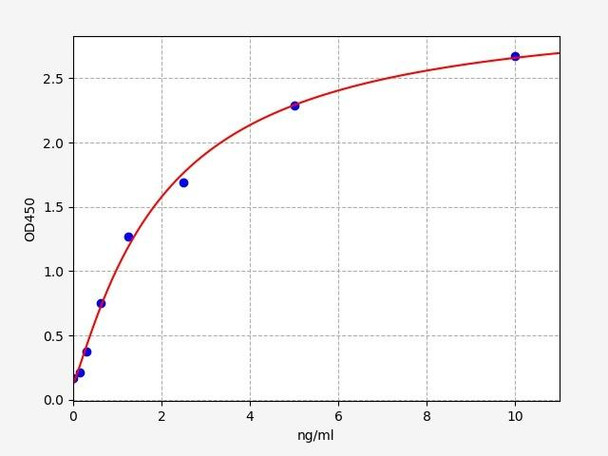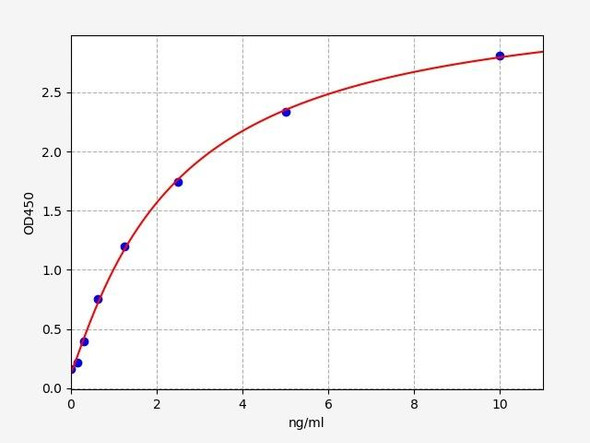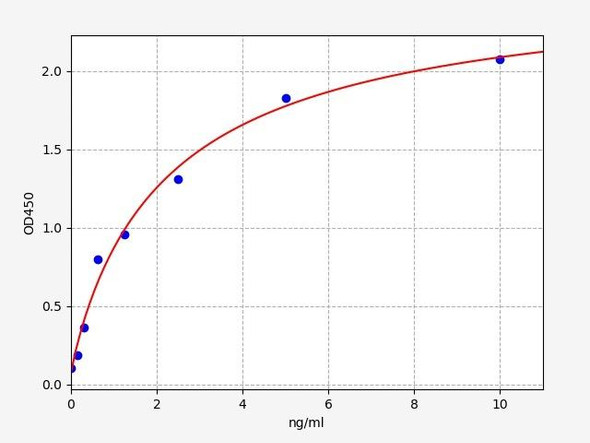Mouse Cell Signalling ELISA Kits 5
Mouse ABCA1 / ATP-binding cassette sub-family A member 1 ELISA Kit
- SKU:
- MOFI00374
- Product Type:
- ELISA Kit
- Size:
- 96 Assays
- Uniprot:
- P41233
- Sensitivity:
- 0.094ng/ml
- Range:
- 0.156-10ng/ml
- ELISA Type:
- Sandwich
- Synonyms:
- Abca1, ABCA1, ATP-binding cassette transporter A1, ABC1, CERP, HDLDT1, TGD, ABC-1, ATP-binding cassette 1, ATP-binding cassette transporter 1, ATP-binding cassette, sub-family A, member 1, Cholesterol efflux regulatory protein, membrane-bound, TGDATP
- Reactivity:
- Mouse
- Research Area:
- Signal Transduction
Description
| Product Name: | Mouse ABCA1 / ATP-binding cassette sub-family A member 1 ELISA Kit |
| Product Code: | MOFI00374 |
| Size: | 96 Assays |
| Alias: | Abca1, ABCA1, ATP-binding cassette transporter A1, ABC1, CERP, HDLDT1, TGD, ABC-1, ATP-binding cassette 1, ATP-binding cassette transporter 1, ATP-binding cassette, sub-family A, member 1, Cholesterol efflux regulatory protein, membrane-bound, TGDATP-binding cassette sub-family A member 1 |
| Detection Method: | Sandwich ELISA |
| Application: | This immunoassay kit allows for the in vitro quantitative determination of Mouse Abca1 concentrations in serum plasma and other biological fluids. |
| Sensitivity: | 0.094ng/ml |
| Range: | 0.156-10ng/ml |
| Storage: | 4°C for 6 months |
| Note: | For Research Use Only |
| Recovery: | Matrices listed below were spiked with certain level of Mouse Abca1 and the recovery rates were calculated by comparing the measured value to the expected amount of Mouse Abca1 in samples. | ||||||||||||||||
| |||||||||||||||||
| Linearity: | The linearity of the kit was assayed by testing samples spiked with appropriate concentration of Mouse Abca1 and their serial dilutions. The results were demonstrated by the percentage of calculated concentration to the expected. | ||||||||||||||||
| |||||||||||||||||
| Intra Assay: | CV <8% | ||||||||||||||||
| Inter Assay: | CV <10% |
| Component | Quantity | Storage |
| ELISA Microplate (Dismountable) | 8-12 strips | 4°C for 6 months |
| Lyophilized Standard | 2 | 4°C/-20°C |
| Sample/Standard Dilution Buffer | 20ml | 4°C |
| Biotin-labeled Antibody(Concentrated) | 120ul | 4°C (Protect from light) |
| Antibody Dilution Buffer | 10ml | 4°C |
| HRP-Streptavidin Conjugate(SABC) | 120ul | 4°C (Protect from light) |
| SABC Dilution Buffer | 10ml | 4°C |
| TMB Substrate | 10ml | 4°C (Protect from light) |
| Stop Solution | 10ml | 4°C |
| Wash Buffer(25X) | 30ml | 4°C |
| Plate Sealer | 5 | - |
Other materials and equipment required:
- Microplate reader with 450 nm wavelength filter
- Multichannel Pipette, Pipette, microcentrifuge tubes and disposable pipette tips
- Incubator
- Deionized or distilled water
- Absorbent paper
- Buffer resevoir
| Uniprot | P41233 |
| UniProt Protein Function: | ABCA1: an ATP-binding cassette (ABC) transporter that regulates cholesterol homeostasis and insulin secretion in beta-cells, and protects against cardiovascular disease. Inactivation of ABCA1 in beta-cells markedly impairs glucose tolerance and insulin secretion in mice. Rosiglitazone, an activator of the peroxisome proliferator-activated receptor-gamma, upregulates ABCA1 in beta-cells. ABCA1 expression in beta-cells is required for the beneficial effects of rosiglitazone on glucose tolerance. Mediates the transport of cholesterol and phospholipids from cells to HDL apolipoproteins, modulating HDL levels and atherogenesis. Induced by bacterial lipopolysaccharides (LPS) and repressed by ZNF202. Phosphorylation on Ser-2054 regulates phospholipid efflux. Unsaturated fatty acids destabilize ABCA1 by activating a PKC-delta pathway that phosphorylates ABCA1 serines. Defects in ABCA1 are a cause of high density lipoprotein deficiencies. |
| UniProt Protein Details: | Protein type:Membrane protein, multi-pass; Membrane protein, integral; Transporter; Transporter, ABC family; Vesicle Cellular Component: Golgi apparatus; cell surface; intracellular membrane-bound organelle; membrane; perinuclear region of cytoplasm; integral to plasma membrane; endocytic vesicle; plasma membrane; integral to membrane; phagocytic vesicle; external side of plasma membrane; lipid raft Molecular Function:apolipoprotein A-I receptor activity; transporter activity; ATPase activity; nucleotide binding; apolipoprotein binding; ATPase binding; small GTPase binding; apolipoprotein A-I binding; protein binding; phospholipid transporter activity; syntaxin binding; ATPase activity, coupled to transmembrane movement of substances; cholesterol transporter activity; anion transmembrane transporter activity; ATP binding; receptor binding Biological Process: cholesterol metabolic process; regulation of Cdc42 protein signal transduction; cholesterol transport; response to high density lipoprotein stimulus; cholesterol efflux; intracellular cholesterol transport; lipoprotein metabolic process; endosome transport; phospholipid translocation; G-protein coupled receptor protein signaling pathway; cholesterol homeostasis; reverse cholesterol transport; platelet dense granule organization and biogenesis; phospholipid efflux; transport; lysosome organization and biogenesis; lipoprotein biosynthetic process; positive regulation of cAMP biosynthetic process; protein amino acid lipidation; interleukin-1 beta secretion; phospholipid transport; phagocytosis, engulfment; transmembrane transport; phospholipid homeostasis; peptide secretion |
| NCBI Summary: | The membrane-associated protein encoded by this gene is a member of the superfamily of ATP-binding cassette (ABC) transporters. ABC proteins transport various molecules across extra- and intracellular membranes. ABC genes are divided into seven distinct subfamilies (ABC1, MDR/TAP, MRP, ALD, OABP, GCN20, White). This protein is a member of the ABC1 subfamily. Members of the ABC1 subfamily comprise the only major ABC subfamily found exclusively in multicellular eukaryotes. In humans, this protein functions as a cholesterol efflux pump in the cellular lipid removal pathway. Mutations in the human gene have been associated with Tangier's disease and familial high-density lipoprotein deficiency. [provided by RefSeq, Jul 2008] |
| UniProt Code: | P41233 |
| NCBI GenInfo Identifier: | 90568038 |
| NCBI Gene ID: | 11303 |
| NCBI Accession: | NP_038482.3 |
| UniProt Secondary Accession: | P41233,B1AWZ8, |
| UniProt Related Accession: | P41233 |
| Molecular Weight: | |
| NCBI Full Name: | ATP-binding cassette sub-family A member 1 |
| NCBI Synonym Full Names: | ATP-binding cassette, sub-family A (ABC1), member 1 |
| NCBI Official Symbol: | Abca1 |
| NCBI Official Synonym Symbols: | Abc1; ABC-1 |
| NCBI Protein Information: | ATP-binding cassette sub-family A member 1; ATP-binding cassette 1; ATP-binding cassette transporter 1 |
| UniProt Protein Name: | ATP-binding cassette sub-family A member 1 |
| UniProt Synonym Protein Names: | ATP-binding cassette transporter 1; ABC-1; ATP-binding cassette 1 |
| Protein Family: | ABC transporter A family |
| UniProt Gene Name: | Abca1 |
| UniProt Entry Name: | ABCA1_MOUSE |
*Note: Protocols are specific to each batch/lot. For the correct instructions please follow the protocol included in your kit.
| Step | Procedure |
| 1. | Set standard, test sample and control (zero) wells on the pre-coated plate respectively, and then, record their positions. It is recommended to measure each standard and sample in duplicate. Wash plate 2 times before adding standard, sample and control (zero) wells! |
| 2. | Aliquot 0.1ml standard solutions into the standard wells. |
| 3. | Add 0.1 ml of Sample / Standard dilution buffer into the control (zero) well. |
| 4. | Add 0.1 ml of properly diluted sample (Human serum, plasma, tissue homogenates and other biological fluids.) into test sample wells. |
| 5. | Seal the plate with a cover and incubate at 37 °C for 90 min. |
| 6. | Remove the cover and discard the plate content, clap the plate on the absorbent filter papers or other absorbent material. Do NOT let the wells completely dry at any time. Wash plate X2. |
| 7. | Add 0.1 ml of Biotin- detection antibody working solution into the above wells (standard, test sample & zero wells). Add the solution at the bottom of each well without touching the side wall. |
| 8. | Seal the plate with a cover and incubate at 37°C for 60 min. |
| 9. | Remove the cover, and wash plate 3 times with Wash buffer. Let wash buffer rest in wells for 1 min between each wash. |
| 10. | Add 0.1 ml of SABC working solution into each well, cover the plate and incubate at 37°C for 30 min. |
| 11. | Remove the cover and wash plate 5 times with Wash buffer, and each time let the wash buffer stay in the wells for 1-2 min. |
| 12. | Add 90 µL of TMB substrate into each well, cover the plate and incubate at 37°C in dark within 10-20 min. (Note: This incubation time is for reference use only, the optimal time should be determined by end user.) And the shades of blue can be seen in the first 3-4 wells (with most concentrated standard solutions), the other wells show no obvious color. |
| 13. | Add 50 µL of Stop solution into each well and mix thoroughly. The color changes into yellow immediately. |
| 14. | Read the O.D. absorbance at 450 nm in a microplate reader immediately after adding the stop solution. |
When carrying out an ELISA assay it is important to prepare your samples in order to achieve the best possible results. Below we have a list of procedures for the preparation of samples for different sample types.
| Sample Type | Protocol |
| Serum: | If using serum separator tubes, allow samples to clot for 30 minutes at room temperature. Centrifuge for 10 minutes at 1,000x g. Collect the serum fraction and assay promptly or aliquot and store the samples at -80°C. Avoid multiple freeze-thaw cycles. If serum separator tubes are not being used, allow samples to clot overnight at 2-8°C. Centrifuge for 10 minutes at 1,000x g. Remove serum and assay promptly or aliquot and store the samples at -80°C. Avoid multiple freeze-thaw cycles. |
| Plasma: | Collect plasma using EDTA or heparin as an anticoagulant. Centrifuge samples at 4°C for 15 mins at 1000 - g within 30 mins of collection. Collect the plasma fraction and assay promptly or aliquot and store the samples at -80°C. Avoid multiple freeze-thaw cycles. Note: Over haemolysed samples are not suitable for use with this kit. |
| Urine & Cerebrospinal Fluid: | Collect the urine (mid-stream) in a sterile container, centrifuge for 20 mins at 2000-3000 rpm. Remove supernatant and assay immediately. If any precipitation is detected, repeat the centrifugation step. A similar protocol can be used for cerebrospinal fluid. |
| Cell culture supernatant: | Collect the cell culture media by pipette, followed by centrifugation at 4°C for 20 mins at 1500 rpm. Collect the clear supernatant and assay immediately. |
| Cell lysates: | Solubilize cells in lysis buffer and allow to sit on ice for 30 minutes. Centrifuge tubes at 14,000 x g for 5 minutes to remove insoluble material. Aliquot the supernatant into a new tube and discard the remaining whole cell extract. Quantify total protein concentration using a total protein assay. Assay immediately or aliquot and store at ≤ -20°C. |
| Tissue homogenates: | The preparation of tissue homogenates will vary depending upon tissue type. Rinse tissue with 1X PBS to remove excess blood & homogenize in 20ml of 1X PBS (including protease inhibitors) and store overnight at ≤ -20°C. Two freeze-thaw cycles are required to break the cell membranes. To further disrupt the cell membranes you can sonicate the samples. Centrifuge homogenates for 5 mins at 5000xg. Remove the supernatant and assay immediately or aliquot and store at -20°C or -80°C. |
| Tissue lysates: | Rinse tissue with PBS, cut into 1-2 mm pieces, and homogenize with a tissue homogenizer in PBS. Add an equal volume of RIPA buffer containing protease inhibitors and lyse tissues at room temperature for 30 minutes with gentle agitation. Centrifuge to remove debris. Quantify total protein concentration using a total protein assay. Assay immediately or aliquot and store at ≤ -20 °C. |
| Breast Milk: | Collect milk samples and centrifuge at 10,000 x g for 60 min at 4°C. Aliquot the supernatant and assay. For long term use, store samples at -80°C. Minimize freeze/thaw cycles. |






